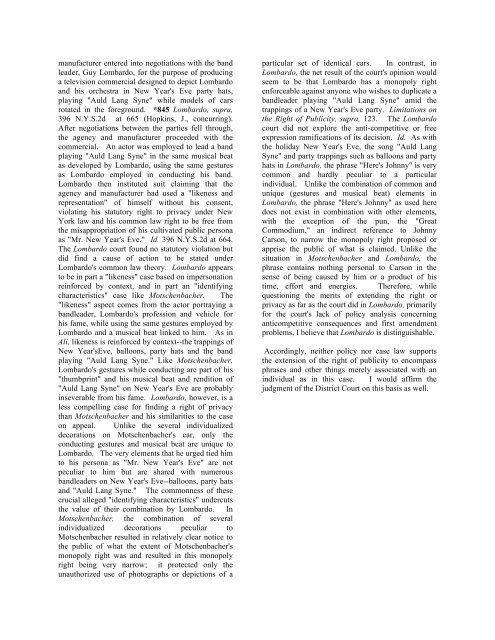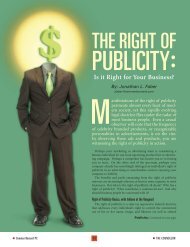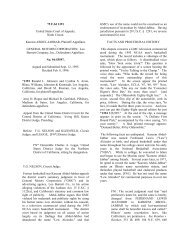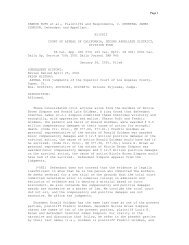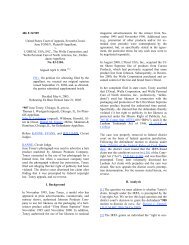Johnny Carson v. Here's Johnny Portable Toilets ... - Right Of Publicity
Johnny Carson v. Here's Johnny Portable Toilets ... - Right Of Publicity
Johnny Carson v. Here's Johnny Portable Toilets ... - Right Of Publicity
You also want an ePaper? Increase the reach of your titles
YUMPU automatically turns print PDFs into web optimized ePapers that Google loves.
manufacturer entered into negotiations with the bandleader, Guy Lombardo, for the purpose of producinga television commercial designed to depict Lombardoand his orchestra in New Year's Eve party hats,playing "Auld Lang Syne" while models of carsrotated in the foreground. *845 Lombardo, supra,396 N.Y.S.2d at 665 (Hopkins, J., concurring).After negotiations between the parties fell through,the agency and manufacturer proceeded with thecommercial. An actor was employed to lead a bandplaying "Auld Lang Syne" in the same musical beatas developed by Lombardo, using the same gesturesas Lombardo employed in conducting his band.Lombardo then instituted suit claiming that theagency and manufacturer had used a "likeness andrepresentation" of himself without his consent,violating his statutory right to privacy under NewYork law and his common law right to be free fromthe misappropriation of his cultivated public personaas "Mr. New Year's Eve." Id. 396 N.Y.S.2d at 664.The Lombardo court found no statutory violation butdid find a cause of action to be stated underLombardo's common law theory. Lombardo appearsto be in part a "likeness" case based on impersonationreinforced by context, and in part an "identifyingcharacteristics" case like Motschenbacher. The"likeness" aspect comes from the actor portraying abandleader, Lombardo's profession and vehicle forhis fame, while using the same gestures employed byLombardo and a musical beat linked to him. As inAli, likeness is reinforced by context--the trappings ofNew Year'sEve, balloons, party hats and the bandplaying "Auld Lang Syne." Like Motschenbacher,Lombardo's gestures while conducting are part of his"thumbprint" and his musical beat and rendition of"Auld Lang Syne" on New Year's Eve are probablyinseverable from his fame. Lombardo, however, is aless compelling case for finding a right of privacythan Motschenbacher and his similarities to the caseon appeal. Unlike the several individualizeddecorations on Motschenbacher's car, only theconducting gestures and musical beat are unique toLombardo. The very elements that he urged tied himto his persona as "Mr. New Year's Eve" are notpeculiar to him but are shared with numerousbandleaders on New Year's Eve--balloons, party hatsand "Auld Lang Syne." The commonness of thesecrucial alleged "identifying characteristics" undercutsthe value of their combination by Lombardo. InMotschenbacher, the combination of severalindividualized decorations peculiar toMotschenbacher resulted in relatively clear notice tothe public of what the extent of Motschenbacher'smonopoly right was and resulted in this monopolyright being very narrow; it protected only theunauthorized use of photographs or depictions of aparticular set of identical cars. In contrast, inLombardo, the net result of the court's opinion wouldseem to be that Lombardo has a monopoly rightenforceable against anyone who wishes to duplicate abandleader playing "Auld Lang Syne" amid thetrappings of a New Year's Eve party. Limitations onthe <strong>Right</strong> of <strong>Publicity</strong>, supra, 123. The Lombardocourt did not explore the anti-competitive or freeexpression ramifications of its decision. Id. As withthe holiday New Year's Eve, the song "Auld LangSyne" and party trappings such as balloons and partyhats in Lombardo, the phrase "<strong>Here's</strong> <strong>Johnny</strong>" is verycommon and hardly peculiar to a particularindividual. Unlike the combination of common andunique (gestures and musical beat) elements inLombardo, the phrase "<strong>Here's</strong> <strong>Johnny</strong>" as used heredoes not exist in combination with other elements,with the exception of the pun, the "GreatCommodium," an indirect reference to <strong>Johnny</strong><strong>Carson</strong>, to narrow the monopoly right proposed orapprise the public of what is claimed. Unlike thesituation in Motschenbacher and Lombardo, thephrase contains nothing personal to <strong>Carson</strong> in thesense of being caused by him or a product of histime, effort and energies. Therefore, whilequestioning the merits of extending the right orprivacy as far as the court did in Lombardo, primarilyfor the court's lack of policy analysis concerninganticompetitive consequences and first amendmentproblems, I believe that Lombardo is distinguishable.Accordingly, neither policy nor case law supportsthe extension of the right of publicity to encompassphrases and other things merely associated with anindividual as in this case. I would affirm thejudgment of the District Court on this basis as well.


